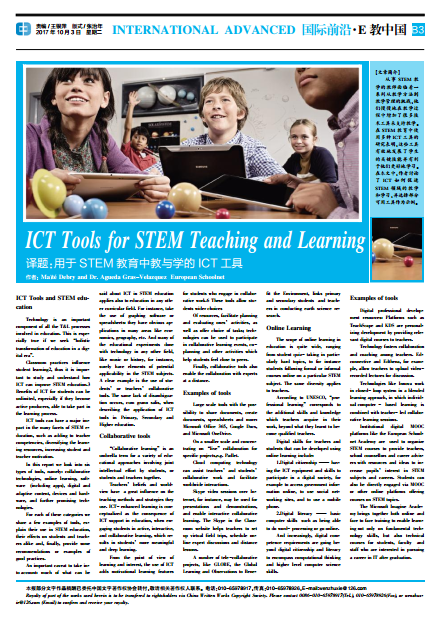【文章简介】
从事STEM教学的教师面临着一系列从教学方法到教学管理的挑战,他们慢慢地在教学过程中增加了很多技术工具来支持教学。在STEM教育中使用多种ICT工具的研究表明,这些工具有效地发展了学生的关键技能并有利于他们更好地学习。在本文中,作者讨论了ICT如何促进STEM领域的教学和学习,并选择部分可用工具作为示例。
ICT Tools and STEM education

Technology is an important component of all the T&L processes involved in education. This is especially true if we seek “holistic transformation of education in a digital era”.
Classroom practices influence student learning2, thus it is important to study and understand how ICT can improve STEM education.3 Benefits of ICT for students can be unlimited, especially if they become active producers, able to take part in the learning process.
ICT tools can have a major impact in the many facets of STEM education, such as adding to teacher competencies, diversifying the learning resources, increasing student and teacher motivation.
In this report we look into six types of tools, namely: collaborative technologies, online learning, software (including apps), digital and adaptive content, devices and hardware, and further promising technologies.
For each of these categories we share a few examples of tools, explain their use in STEM education, their effects on students and teachers alike and, finally, provide some recommendations or examples of good practices.
An important caveat to take into account: much of what can be said about ICT in STEM education applies also to education in any other curricular field. For instance, take the use of graphing software or spreadsheets: they have obvious applications in many areas like economics, geography, etc. And many of the educational experiments done with technology in any other field, like music or history, for instance, surely have elements of potential applicability in the STEM subjects. A clear example is the use of students’ or teachers’ collaborative tools. The same lack of disambiguation occurs, cum grano salis, when describing the application of ICT tools in Primary, Secondary and Higher education.
Collaborative tools
“Collaborative learning” is an umbrella term for a variety of educational approaches involving joint intellectual effort by students, or students and teachers together.
Teachers’ beliefs and worldview have a great influence on the teaching methods and strategies they use. ICT- enhanced learning is conceptualized as the consequence of ICT support in education, when engaging students in active, interactive, and collaborative learning, which results in students’ more meaningful and deep learning.
From the point of view of learning and interest, the use of ICT adds motivational learning features for students who engage in collaborative work.6 These tools allow students wider choices
Of resources, facilitate planning and evaluating ones’ activities, as well as offer choice of tasks; technologies can be used to participate in collaborative learning events, co-planning and other activities which help students feel close to peers.
Finally, collaborative tools also enable the collaboration with experts at a distance.
Examples of tools
Large scale tools with the possibility to share documents, create documents, spreadsheets and more: Microsoft Office 365, Google Docs, and Microsoft OneDrive.
On a smaller scale and concentrating on“live” collaboration for specific projects,e.g. Padlet.
Cloud computing technology can assist teachers’ and students’ collaborative work and facilitate worldwide interactions.
Skype video sessions over Internet, for instance, may be used for presentations and demonstrations, and enable interactive collaborative learning. The Skype in the Classroom website helps teachers to set up virtual field trips, schedule online expert discussions and distance lessons.
A number of tele-collaborative projects, like GLOBE, the Global Learning and Observations to Benefit the Environment, links primary and secondary students and teachers in conducting earth science research.
Online Learning
The scope of online learning in education is quite wide, ranging from student quiz- taking in particularly hard topics, to for instance students following formal or informal courses online on a particular STEM subject. The same diversity applies to teachers.
According to UNESCO, “professional learning” corresponds to the additional skills and knowledge which teachers acquire in their work, beyond what they learnt to become qualified teachers.
Digital skills for teachers and students that can be developed using online learning include:
1.Digital citizenship —— having the ICT equipment and skills to participate in a digital society, for example to access government information online, to use social networking sites, and to use a mobile phone.
2.Digital literacy —— basic computer skills such as being able to do word- processing or go online.
And increasingly, digital competence requirements are going beyond digital citizenship and literacy to encompass computational thinking and higher level computer science skills.
Examples of tools
Digital professional development resources: Platforms such as TeachScape and KDS are personalizing development by providing relevant digital courses to teachers.
Technology fosters collaboration and coaching among teachers. Edconnective and Edthena, for example, allow teachers to upload video-recorded lectures for discussion.
Technologies like Innova work in closed- loop system in a blended learning approach, in which individual computer- based learning is combined with teacher- led collaborative learning sessions.
Institutional digital MOOC platforms like the European Schoolnet Academy are used to organize STEM courses to provide teachers, school counsellors and career advisers with resources and ideas to increase pupils’ interest in STEM subjects and careers. Students can also be directly engaged via MOOC or other online platforms offering courses on STEM topics.
The Microsoft Imagine Academy brings together both online and face to face training to enable learning not only on fundamental technology skills, but also technical courses for students, faculty and staff who are interested in pursuing a career in IT after graduation.


